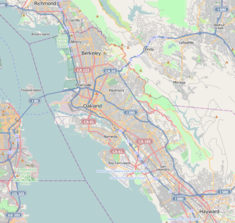Rancho San Antonio (Peralta)
| Rancho San Antonio (Peralta Grant) | |
|---|---|
| Location | Northern portion of Alameda County, California |
| Coordinates | 37°43′50.64″N 122°9′41.4″W / 37.7307333°N 122.161500°W |
| Built | 1820 |
| Designated | 1936 |
| Reference no. | 246[1] |
Rancho San Antonio, also known as the Peralta Grant, was a 44,800-acre (181 km2)
History

The hacienda became the social and commercial center of this vast rancho. Annual
In 1842, Luís María Peralta decided to split the rancho among his sons. His five daughters received his cattle and his San Jose adobe (the Peralta Adobe) and land. He died in 1851, but not before telling his sons to steer clear of the California gold rush, stating, "The land is our gold." However, it would not be easy for the Peraltas to hold on to their property.
Although the United States government promised all rights of citizenship and property ownership to the
By 1860, the brothers' land holdings had been substantially reduced, partly to pay for the previous decade's litigation and to cover newly imposed property taxes. Among the lawyers representing them were Horace Carpentier who acquired large chunks of the Peralta lands as compensation for his services. After the 1868 Hayward earthquake destroyed many of the rancho's buildings, Antonio (the third son), built what is now known as the Peralta Hacienda, an Italianate Victorian two-story frame house in 1870, located in what is today the Fruitvale district of Oakland.
In 1872, the combined property of the sons of Luís María Peralta was assessed at approximately $200,000 (their father's estate had been valued at $1,383,500 at the time of his death, equivalent to $38 million in 2023). By the time of Antonio Peralta's death in 1879, he only had 23 acres (93,000 m2) left of the original 16,067 acres (65.02 km2) his father gave him.
In the end, the 1870 house and the remnants of Antonio's share of the land grant were sold by his daughter Inez Galindo in 1897 to developer Henry Z. Jones who laid out streets and parcels and moved the 1870 house to its present location. That house and a brick house (the Peralta Home built by the eldest son Ignacio in 1860) are the only two remaining structures out of the entire complex. The 1870 House now sits in Peralta Hacienda Historical Park in Oakland and is open for tours.[2]
Historic designations
- Rancho San Antonio,[1] California Historical Landmark #246 (the commemorative plaque can be found in San Leandro).
- Joaquin Miller House
- National Historic Landmark
- National Register of Historic Places, NPS-66000204.
- California Historical Landmark #107
- Oakland Designated Landmark#5
- Antonio Maria Peralta House
- National Register of Historic Places 77000285
- California Historical Landmark #925[3]
- Oakland Designated Landmark#10
- Camino of Rancho San Antonio, California Historical Landmark #299:[4] The road ran from Mission San José to Fruitvale and later to San Pablo by way of Oakland and El Cerrito.
- Tower to John C. Frémont, Oakland Designated Landmark #4
References
Sources
- The Peraltas and Their Houses, by Jacob N. Bowman, published by the Alameda County Historical Society (2001)
Footnotes
- ^ a b c "Rancho San Antonio". Office of Historic Preservation, California State Parks. Retrieved 2012-10-06.
- ^ Peralta Hacienda Historical Park website
- ^ "Peralta Hacienda Site". Office of Historic Preservation, California State Parks. Retrieved 2012-03-20.
- ^ "Camino Of Rancho San Antonio". Office of Historic Preservation, California State Parks. Retrieved 2012-03-20.
External links
- Peralta Hacienda Historical Park - Museum of History and Community
- Peralta Land Claim Confirmation, US District Court, 1852
- "Rancho San Antonio - California Historical Landmark no. 246". library.ucsd.edu. 1936–1940.



